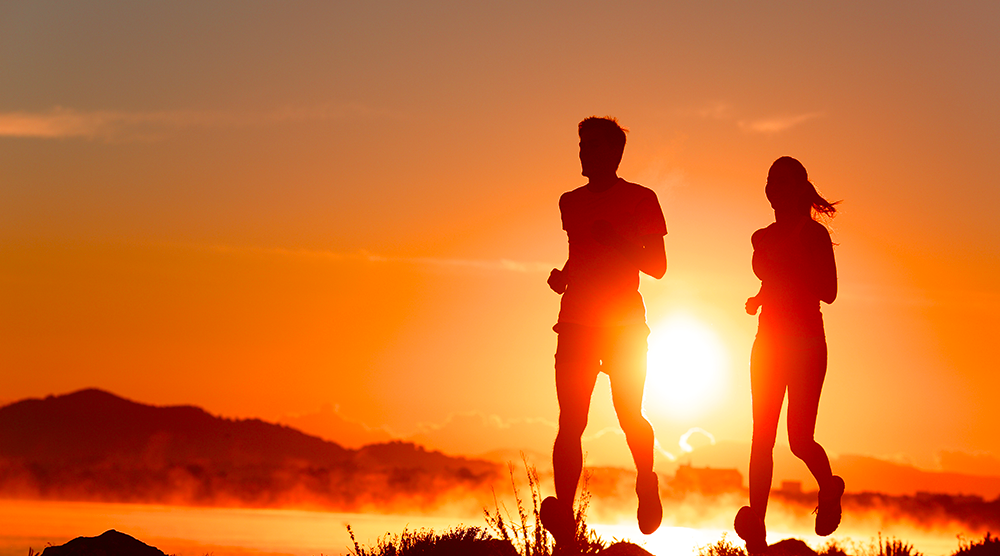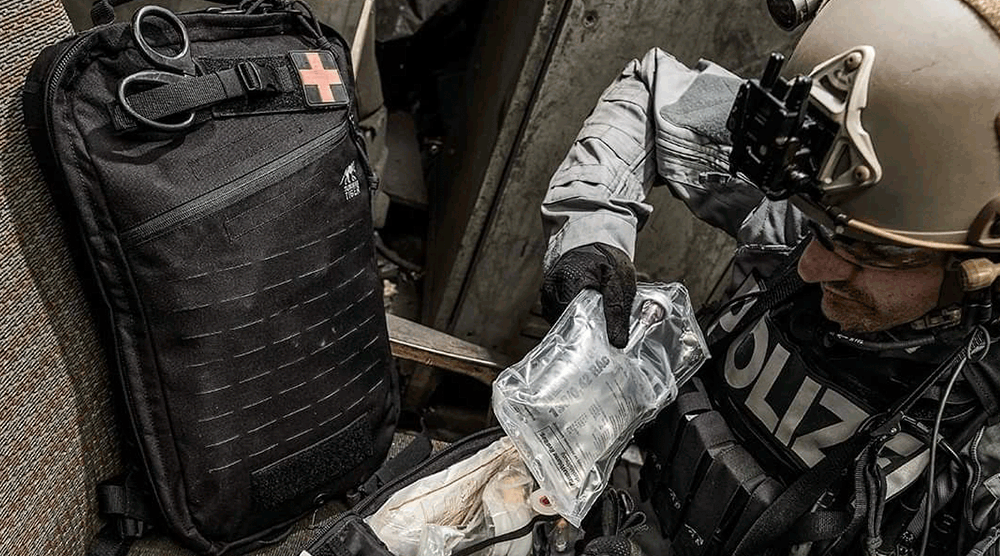
A Guide to Running in the Heat
The temperature is rising and reaching record-breaking highs depending on where you live in the country. During the recent heatwave, tourists flocked to Death Valley, CA, to witness some of the hottest temperatures on Earth at 130 degrees. But despite these all-time highs, we know elite family members like you have an attitude of "no excuses" when it comes to training. Plus, you have had your sights set on leaving your house this year to take on and train for that 5K. Or insert whatever activity doesn't involve sitting at home in front of a screen. So here's the skinny on how you can increase your stamina, take on that 5K outside in nature, and keep from melting under the oppressive heat.
When planning how to train, there are conditions you can plan for and others you can't. Things you can prepare for like where you are going, the route that you take, generally what season it will be, and what you are wearing are a few. Knowing how to plan for these things alone can give you a good chance of completing your workout and eventually finding a way to come out on top in your event.
You can't control other conditions, like the heat index reaching up to you’ve got to be kidding me.
And if you're planning to run at an event in the summer, chances are it's going to be blazing. So, start with these acclimation training tips that will help you go the distance.
You may be familiar with the U.S. Marine Corps development of wet bulb globe temperature (WBGT). WBGT is a metric for those planning to work (or, in this case, train) in direct sunlight. It accounts for humidity, wind speed, sun angle, solar radiation, and temperature in areas without shade.
Runners can use WBGT is to gauge how long an average person can run before reaching heat exhaustion. For instance, if the WBGT is over 90, they recommend running for 15 minutes or less and taking a 45-minute break in the shade each hour.
Keep measures like the WBGT in mind, along with the right plan, fuel, and tools, to help create a successful journey.
Couch to 5K
"This isn't for you. It's for your friends." One coach would preface with this when he was about to tell me something I believed that I had already mastered.
You probably have run a 5K (and beyond) before, but your friends are new to running. This tip isn't for you. It's for them.
If you have big goals in mind, you're likely going to train harder than ever.
When the weather warms up, if you haven't run in the heat lately... start at a conservative pace. Then, check in to see how you feel.
We're not your therapist trying to get you in touch with your feelings. But if you are going to coach yourself, you will want to know what your body feels like when it feels strong and weak.
If you feel strong, that's your permission slip to train harder.
If you feel headache, dizziness, or nausea, those are the signs you are experiencing heat stress. At that point, you aren't doing yourself any favors by continuing. You're better off picking it up again tomorrow.
No matter who you are, the heat can get the best of anyone.
Play it smart by increasing your water intake and using this handy calculator to help plan your running pace based on the conditions.
Perspiration: Keep Your Cool
Keeping your cool is a critical piece in helping you in longer races, literally. Everyone knows that while running in warm or cool temperatures can produce a lot of sweat. Sweating during a run can increase your blood plasma volume, which reduces your overall core temperature. When it comes to the big day, the more you sweat, the easier it will be to maintain homeostasis and prevent heat exhaustion.
In other words, if you can't stand the heat, try standing in the kitchen for at least 10 minutes.
In dry heat, sweat can also help you keep cool. It helps with evaporative cooling - your own personal A/C unit.
In humid climates, your sweat can't evaporate into the air, and it starts to act more like a warm blanket. Read more about this when we share our favorite moisture-wicking shirts.
Depending on your perfectionist levels, you may be concerned with speed, distance, and form. Remember that a day acclimating to heat is like a hard day at the gym. So here is a pro tip, substitute running quality for acclimation. Just like strength training, you don't need to go hard every day on every muscle group. You take certain days to train one muscle group, then rotate muscle groups throughout the week.
Save quality running for a cooler part of the day. Generally speaking, from 11 am - 3 pm, the sun can become unbearable. So, plan to head to train your form early in the morning or wait until late evening.
Running With A Water Bottle
When you become a runner, water should be your new favorite beverage. And while you may be able to run short distances without carrying a water bottle, eventually, you will need one if you are going for a long distance.
It may feel like a bit of a nuisance to carry a water bottle while running. However, hydration is critical to your body's performance. Experts recommend 30-40 ounces per hour - or four to five cups.
In addition to water, you should be replenishing your energy with salt. There are many excellent electrolyte drink options available for runners. Once you find one that you like, drink it like you are getting paid to do it. Enough to keep you looking refreshed but not so much that you feel bloated. Proper hydration will give you energy as well as prevent headaches, nausea, and lightheadedness.
Here's a free cheat code. Keeping your drinks cold is like a one 1Up in Mario. You gain extra life when you're training under stressful circumstances.
In dry climates, you can also use water to cool your body temperature. In this case, you may want to bring some water to drink and the rest to pour on your neck or wrists while you run.
Eating Before A Run
When it comes to choosing the best food before a run, it's less about protein than you might think.
If you decide to eat before a quick run, something like a banana will do the trick. You'll want something that will burn fast.
For longer runs, however, balancing your macros is the name of the game. If you're going to favor any macros over another, make sure it's carbs or fat.
Digestion is one of the most energy-consuming processes that your body naturally does throughout the day. Protein is hard to digest. Giving your body a big job to digest before a run takes away from the energy you need for running. So to avoid muscle cramps, heat cramps, and heat exhaustion, go for oatmeal with berries or toast with nut butter.
Other foods to avoid are excessive amounts of dairy. Dairy can have a lot of protein. Adding a tablespoon of cream cheese to a bagel won't hurt, but that should be your maximum. Foods that may result in an unintended trip to the bushes are high-fiber fruits and vegetables, spicy food, and coffee.
MapMyRun
Using an app like MapMyRun can help you stay motivated, track your progress and stay physically safe. Writing your goals down, even in app form, will help you follow through. However, there is another essential tip for everyone. We've watched enough episodes of I Shouldn't Be Alive to know it helps if someone else knows your route and schedule - no matter who you are. Some people like to have a running buddy. But if you're going alone, even if you know the area, remember that anything could happen. While most of the time you'll be fine, it's better to be safe than sorry.
Aside from your route, your environment can have a considerable impact on unseen factors. One concern for runners in the mountains is hypoxia or lack of oxygen to tissues. So, checking elevation levels can help you be aware of places you may need more time to catch your breath or stock up in some cans of air they sell in places like Colorado.
Surprisingly, working in high humidity environments can be as debilitating as working at high altitudes. If you're looking for a helpful and inexpensive app to monitor humidity where you live, try Dark Sky. This app is the most accurate when it comes to viewing daily weather reports.
Moisture Wicking Shirts
You don't have to be Bill Nye to know climate plays a role in how much we can sweat. Sweating can be excellent in dry heat when a cool breeze passes by. But when your sweat has nowhere to go on a humid day, you're going to want to invest in a t-shirt offering breathability. Investing in sweat-wicking apparel means your clothes will absorb perspiration and prevent that warm blanket of sweat from weighing you down.
Plus, many moisture-wicking items offer UV protection as well. Avoiding sunburn will help your skin stay cool, again helping with ventilation.
It's all about staying cool.
Having proper ventilation will allow you to go further and take shorter breaks. Another pro tip is to keep from fanning yourself in dry heat with warm air. The act of fanning yourself creates energy, AKA more heat... which defeats the purpose.
This can be true in the shade as well if it's a sweltering day. So, in this case, it's better to train indoors.
Heat Acclimation Without Sunlight
If you live in a cooler climate, are prone to sunburn, or just want to take a day off from being in the sun, there are other ways you can achieve heat acclimation.
Introducing a sauna into your training can be a great tool. Try starting at 10 minutes or less, then working your way up to 20-30 minutes as you grow accustomed to the habit. Some experts suggest that you should avoid drinking water beforehand to enhance the effect of the session.
If you don't have access to a sauna, a hot tub can work. After your run, spend up to 40 minutes in a hot tub. The hot tub will produce a reduction in skin temperature and the onset of sweat.
Of course, the easiest way to practice heat training is layering your clothes. Don't worry about sweat-wicking material in this case, as the goal is to sweat.
Shop our favorite gear for heat acclimation training:




Leave a comment
This site is protected by hCaptcha and the hCaptcha Privacy Policy and Terms of Service apply.